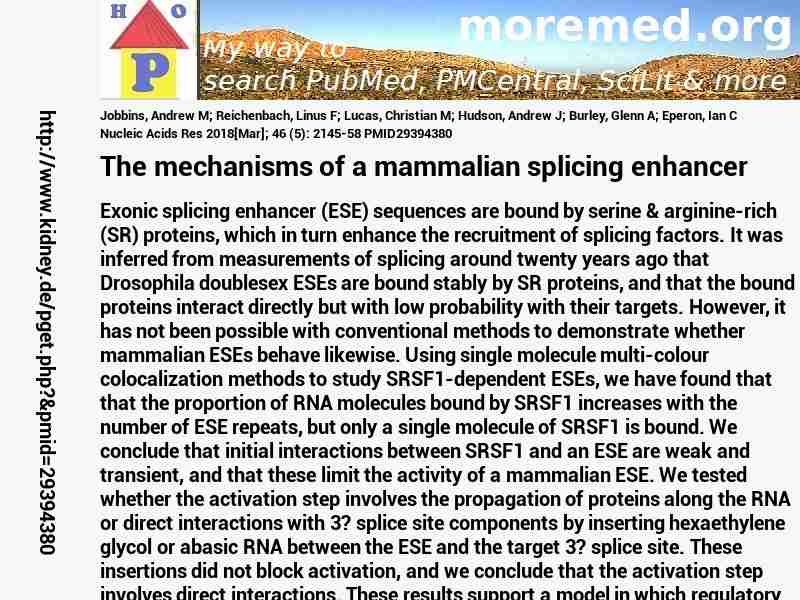
|
10.1093/nar/gky056
http://scihub22266oqcxt.onion/10.1093/nar/gky056

C5861446!5861446!29394380
 free free
 free free
 free free
Warning: file_get_contents(https://eutils.ncbi.nlm.nih.gov/entrez/eutils/elink.fcgi?dbfrom=pubmed&id=29394380&cmd=llinks): Failed to open stream: HTTP request failed! HTTP/1.1 429 Too Many Requests
in C:\Inetpub\vhosts\kidney.de\httpdocs\pget.php on line 215
|  
Warning: imagejpeg(C:\Inetpub\vhosts\kidney.de\httpdocs\phplern\29394380.jpg): Failed to open stream: No such file or directory in C:\Inetpub\vhosts\kidney.de\httpdocs\pget.php on line 117
 Nucleic+Acids+Res 2018 ; 46 (5): 2145-58 Nucleic+Acids+Res 2018 ; 46 (5): 2145-58
Nephropedia Template TP
gab.com Text
Twit Text FOAVip
Twit Text #
English Wikipedia
|
The mechanisms of a mammalian splicing enhancer #MMPMID29394380Jobbins AM; Reichenbach LF; Lucas CM; Hudson AJ; Burley GA; Eperon ICNucleic Acids Res 2018[Mar]; 46 (5): 2145-58 PMID29394380show ga
Exonic splicing enhancer (ESE) sequences are bound by serine & arginine-rich (SR) proteins, which in turn enhance the recruitment of splicing factors. It was inferred from measurements of splicing around twenty years ago that Drosophila doublesex ESEs are bound stably by SR proteins, and that the bound proteins interact directly but with low probability with their targets. However, it has not been possible with conventional methods to demonstrate whether mammalian ESEs behave likewise. Using single molecule multi-colour colocalization methods to study SRSF1-dependent ESEs, we have found that that the proportion of RNA molecules bound by SRSF1 increases with the number of ESE repeats, but only a single molecule of SRSF1 is bound. We conclude that initial interactions between SRSF1 and an ESE are weak and transient, and that these limit the activity of a mammalian ESE. We tested whether the activation step involves the propagation of proteins along the RNA or direct interactions with 3? splice site components by inserting hexaethylene glycol or abasic RNA between the ESE and the target 3? splice site. These insertions did not block activation, and we conclude that the activation step involves direct interactions. These results support a model in which regulatory proteins bind transiently and in dynamic competition, with the result that each ESE in an exon contributes independently to the probability that an activator protein is bound and in close proximity to a splice site.�
  
DeepDyve
Pubget Overpricing | 
|